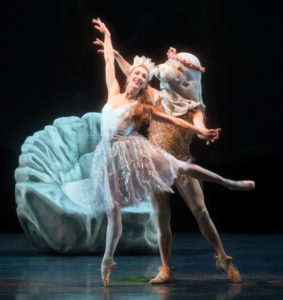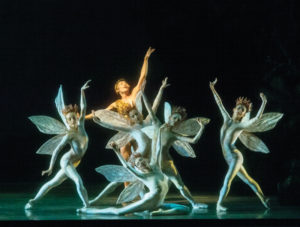Miami City Ballet’s Underwater Shakespeare: Michele Oka Doner designs A Midsummer Night’s Dream - Vancouver Ballet Society
- Home
- Features 2015 - 2019
- Miami City Ballet’s Underwater Shakespeare: Michele Oka Doner designs A Midsummer Night’s Dream

by Karen Barr
George Balanchine’s ballet, A Midsummer Night’s Dream, recently took an unusual twist through the Florida waterways, which inspired newly commissioned sets and costumes by Michele Oka Doner for Miami City Ballet’s 30th anniversary season. Shakespeare’s story of love, quarrels and marriage is set in a magical forest full of fairies and mortals. But Oka Doner, who has always been inspired by subtropical nature and bodies of water such as oceans and its inhabitants, says, “I felt Shakespeare’s forests had been used enough dramatically.”
Oka Doner was a natural choice as designer. Besides being born in Miami, the New York-based artist has an oeuvre spanning more than four decades, including public art commissions (notably for Miami International Airport); sculpture and work on paper found in galleries and museums; design in glass, silver and porcelain; and architectural pieces for homes, from fountains to doorbells. The ballet was Oka Doner’s first foray into costume and the world of dance, a project that took two years to complete and premiered in March 2016 in Miami.
As her vision formed, Oka Doner found photographs in her studio taken underwater in the Port of Miami. These would inspire the ballet’s painted show drop, which the audience sees during the overture. Additionally, Coral Castle, a standing land structure made of 1,000 tons of coral rock in Miami-Dade County, re-imagined from a 1940s vintage photograph taken by Hans Hannau, made its way into Act II as a projected backdrop.
Oka Doner’s greatest design influence arose from her access to the University of Miami’s Marine Invertebrate Museum. “Ninety-thousand jars containing almost one million specimens inspired and sustained the vision,” she says. “I was able to study whole jellyfish and other sea creatures.”
The artist wanted the colours, tones, textures and fabrics of the more than 150 costumes to be just right. “The littoral zone that separates the ocean from land contains a very distinct
palette,” Oka Doner explains. “The golds and browns of sargassum seaweed are characteristic of Miami Beach and used throughout the ballet as the high note.”
Costumes for most lead characters start on a pearly white base that serves as a canvas. Like a seashell, Doner’s designs are not monochromatic, but contain dashes of colour from hand painting, appliqués, embroidery, beading and sequins.

Photo: © Gene Schiavone
Act I takes place near an estuary on Midsummer’s Eve. The fairies are creating a commotion, with Oberon, King of the Fairies, quarrelling with Queen Titania. Dressed like a creature in a magical land, Oberon’s white spandex unitard is appliquéd with stretch velvet branching seaweed. The entire costume is painted and frosted with crystals. His cape is hemstitched, with a riot of painted organza representing seaweed.
Titania is decked out in an ensemble of frothy seaweed fronds made from three layers of organza, with metallic nets on top, liberally sprinkled with crystals. The frond pattern is hand painted on her bodice, with additional crystal-embellished fabric fronds attached. Fronds cover her skirt with a wavy hemline. “Titania’s costume has a bluish tone that evokes the colour of Miami Beach’s ocean through the lens of a translucent jellyfish,” says Oka Doner.
The designer’s favourite character is Puck, who sprinkles the flower dust that casts the spell ensuring the sleeping Queen will fall in love with the first mortal she sees. Puck’s costume is based on bright gold sargassum seaweed. Leaves are made from soft gold leather, with dyed and frizzled organza at the edges. All are connected with a gold cord and golden pearls, layered onto his stretch mesh tunic and attached to his spandex trunk.
As for Bottom, the mortal who becomes the object of Titania’s affections, in Oka Doner’s design he is transformed with the head of a manatee, a bulky creature also known as a sea cow.
In Miami City Ballet’s version of A Midsummer Night’s Dream, Hippolyta makes a grand entrance with seahorses. Her costume, Oka Doner’s favourite, is based on the roots of mangroves, the shrubs or small trees that grow in tropical or subtropical coastal regions. The white leotard is hand crocheted, with a vein pattern made from metallic thread, sequins and beads. The tutu matches, with 3D appliqués made to look like mangrove roots.
At the dress rehearsal, Oka Doner was fascinated at how all the creative elements came together for the first time — choreography, dancers, music, costumes, scenery and lighting. It was a team effort in creativity.

